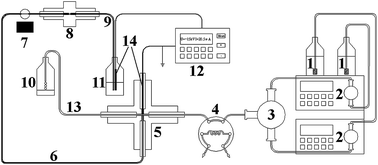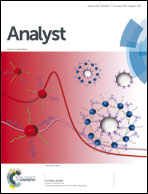A pressure-driven capillary electrophoretic system with injection valve sampling
Abstract
To improve repeatability and efficiency and to simplify the operation procedure of capillary electrophoresis (CE), a pressurized CE system (p-CE) with injection valve sampling was developed. It consisted of one high-pressure pump, a six-port injection valve, a PEEK cross, a separation and back pressure capillary, an ultraviolet-visible detector and a high voltage power supply. The pressure-driven flow ranging from 4.5 nL min−1 to 0.81 μL min−1 in the separation capillary was produced by splitting to the flow from the high-pressure pumps (0.005–0.4 mL min−1). Nano-volume sample injection (<10 nL) was conducted by a micro-volume rotary injector (0.5–5 μL) with flow splitting. In the p-CE system, the new commercial capillary could be directly used without any wash, and the capillary-flush process between runs was also eliminated. In this case, the analytes were driven toward the outlet of the separation capillary by the pressurized flow, the electric field force and minute electroosmotic flow, and they were separated owing to the electrophoretic mobility. The p-CE system allows for the independent variation of the pressurized flow rate and electrical field and electrophoretic separation of good repeatability (below 3%) under high electrical fields (500–1000 V cm−1) and flow rate gradient modes. The feasibility of the p-CE system in real analysis was demonstrated by iodate quantification in iodized table salts. The separation of iodide and iodate was realized within 0.3 min, proving its high analytical speed.


 Please wait while we load your content...
Please wait while we load your content...